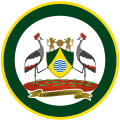This article needs additional citations for verification .(August 2020) |
Nairobi City County | |
|---|---|
 Nairobi City Hall | |
 Location in Kenya | |
| Country | |
| Formed | 4 March 2013 |
| Capital | Nairobi |
| Sub-counties | |
| Government | |
| • Governor | Sakaja Johnson |
| • Senator | Edwin Sifuna |
| • County Woman Representative | Esther Passaris |
| Area | |
• Total | 696.1 km2 (268.8 sq mi) |
| • Rank | 45th |
| Elevation | 1,795 m (5,889 ft) |
| Population (2019) [1] | |
• Total | 4,397,073 |
| • Rank | 1st |
| • Density | 6,300/km2 (16,000/sq mi) |
| Time zone | UTC+03:00 (EAT) |
| HDI (2019) | 0.681 [2] - medium |
| Poverty Rate | 1.3 % [3] - $1.90/day |
| Website | nairobi |
Nairobi City County is one of the 47 counties of Kenya. With an estimated population of 5,454,000 in 2024, it is the third-smallest in area of the counties, yet the most populous. It also serves as the capital of Kenya. The county entity was effected in 2013, replacing Nairobi City Council, which had been the long-standing unit of local administration since before Kenya's independence. The city county consists of eleven gazetted sub-counties and eighty-five electoral wards. On the national level, Nairobi also sends seventeen Members of Parliament across the constituencies, one County Woman Representative to the National Assembly; and one senator to the Senate. The county government, which is allotted devolved functions as stated in the Constitution of Kenya, is headed by a county governor, who appoints his/her cabinet. The county's legislature is headed by the County Speaker, who presides over the County Assembly. The Members of the County Assembly (MCAs) are elected from single-member districts and represent their respective electoral wards. Additional MCAs are also nominated by political parties as a form of affirmative action.
Contents
- Demographics
- Religion
- Administrative and electoral boundaries
- Leadership
- See also
- References
- Notes
- External links
Nairobi City County shares the same boundaries as the former Nairobi Province. Kenya's eight provinces were sub-divided into forty-seven counties as stated in the constitution, based on the forty-seven districts that were established prior to 1992.
On 25 August 2022, after the general elections in Kenya, Johnson Sakaja was sworn-in as the fourth Governor of Nairobi County. [4]


